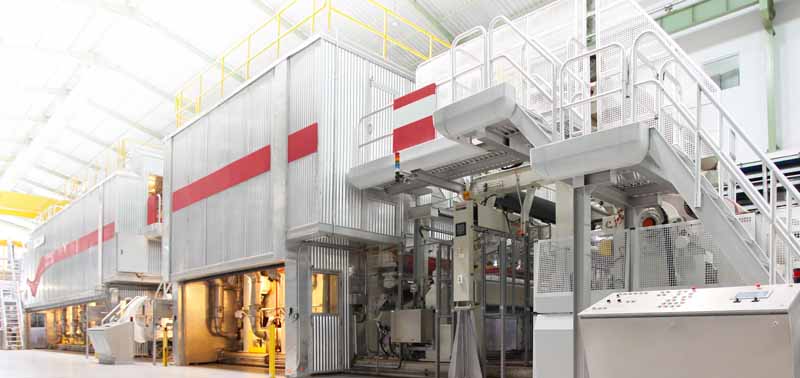Troubled Waters
- Paper Print Edition
- October 1, 2021
- 0
- 2
- 7 minutes read


The cigarette paper sector is coping with rising costs for raw materials, energy and transportation.
By Stefanie Rossel
Paper manufacturers have learned to cope with the pressure brought about by slumping global cigarette consumption and the simultaneous rise of paperless next-generation products. Since 2013, worldwide sales of combustible cigarettes have decreased every year, with consumption standing at 5.06 trillion cigarettes in 2020, down 3.7 percent from 2019, according Euromonitor. In 2019, the combustible cigarette category accounted for an estimated 95 percent of the global tobacco market, down from 94 percent one year previously.
As if this hadn’t been enough, Covid-19 presented a range of further challenges for paper suppliers. “On top of [the shrinking global combustible cigarette market], the situation this year has been exacerbated by container shortages, resulting in higher raw material prices and delivery delays,” says Omar Rahmanadi, CEO of Indonesian cigarette paper maker BMJ. “Nonetheless, like Albert Einstein once said, ‘In the middle of difficulty lies opportunity.’ The global crisis has forced many buyers to revisit their sourcing strategy, which has subsequently opened new business opportunities.”

“Security of supply is even higher on the agenda since the Covid-19 crisis,” says Katrin Hanske, vice president and general manager of SWM’s Tobacco and Alternative Solutions division. “The cigarette paper manufacturers have to ensure a high level of service and quality and must be even more agile in a rapidly changing environment. Having a global footprint and a strong global supply chain is a true advantage to serve our customers located all around the globe.”
“Like the whole world, we were also not prepared to face the challenges of a worldwide pandemic,” says Nina Ritter-Reischl, CEO of Glatz Feinpapiere in Germany. “However, we were able to quickly adapt to the new situation, especially due to our flat hierarchy and short lines of communication. Particularly during the first months of the pandemic, we were faced with high demand for our papers, so we quickly increased our capacity by adapting flexible working hours or shift systems. In combination with the new sanitation and distance regulations, this was a challenge of its own.”
Coping with Costs
Rising prices for raw materials and energy, too, are impacting cigarette paper producers. “The global cigarette paper market in 2021 is dominated by a rapid increase in the costs for pulp,” says Ritter-Reischl. “From January to August, the costs for short fibers have increased over 70 percent and the costs for long fibers over 50 percent. This rapid increase is joined by rising costs for transportation, energy, chemicals and additives in general. Worldwide logistics and workflows still suffer from lockdowns of the Covid-pandemic. Therefore, the cigarette paper industry, just as the paper industry worldwide, is struggling with unexpected high costs, transportation challenges and the consequences of Covid.”
As a consequence of this development, SWM raised prices by up to 15 percent across its engineered papers portfolio on July 1, 2021. The increases, the company said in a press release, were a direct result of sharp rises in raw material prices, with market wood pulp costs up by 50 percent in the past six months. “Largely because of the Covid-19 pandemic, 2020 saw a lower than expected demand for wood pulp and higher inventory levels,” SWM commented. “Since Q4 2020, demand in Asia has recovered strongly, driving inflation and a fast decrease in global inventory levels. Supply levels have turned toward Asia, leading to one of the sharpest price increases in recent history. In addition, polymer prices and packaging material costs remain highly volatile. At the same time, shipping companies are capitalizing on high demand following periods of congestion to leverage their pricing power as well as providing limited visibility on freight rates and special surcharges.”
Although heated-tobacco products represent less than 2 percent of global tobacco retail volumes, according to Euromonitor, they will likely have an impact on the paper business, predicts Rahmanadi. “Heat-not-burn [HnB] products have disrupted the conventional cigarette industry,” he says. “This will undoubtedly disrupt cigarette papers as well. This development requires us as a specialty paper manufacturer to intensify our innovation to support the growth of HnB products.”
Trend Toward Sustainability
Despite current challenges, cigarette paper manufacturers remain optimistic. New business opportunities, they agree, are about to arise from tobacco companies’ focus on sustainability. “This is a trend and customer need we can serve, as it is in our genes,” says Reischl. “As a family-owned company with more than 135 years of history, we are sustainable in more than one way. Not only do we live and work carefully with the resources that nature is giving us—from water quality, emission reduction to energy savings, we [also] yearly reduce our footprint. We are also a sustainable partner for all our business partners, suppliers as well as customers.”
Rahmanadi sees big opportunities in developing a paper-based material that can replace single-use plastics, not necessarily exclusive to the cigarette industry. “The global pandemic has demonstrated that people have the capability to tolerate changes more than what they thought they could. This could mean that people might be willing to sacrifice convenience for environmental sustainability by using paper-based materials instead of plastics, among others,” he says.
“With the EU’s 2019 single-use plastics directive, paper filters made from cellulose fibers represent a great sustainable alternative for the industry,” notes Hanske. “They provide many benefits being an efficient plastic-free solution made with 100 percent renewable raw material, leaving no trace thanks to its faster degradation. We also observe that the industry is looking to use more natural materials for their packaging. It is again an opportunity for SWM to put decades of know-how at the service of the market.”
According to Hanske, SWM is ready to serve its customers no matter where the market takes them. “Beyond cigarette papers, the priority at SWM today is to offer the technical solutions needed by our customers to adapt and grow their business, be it in the traditional cigarette market or in the developing spaces like heated-tobacco products, smokeless or cannabinoids.”

